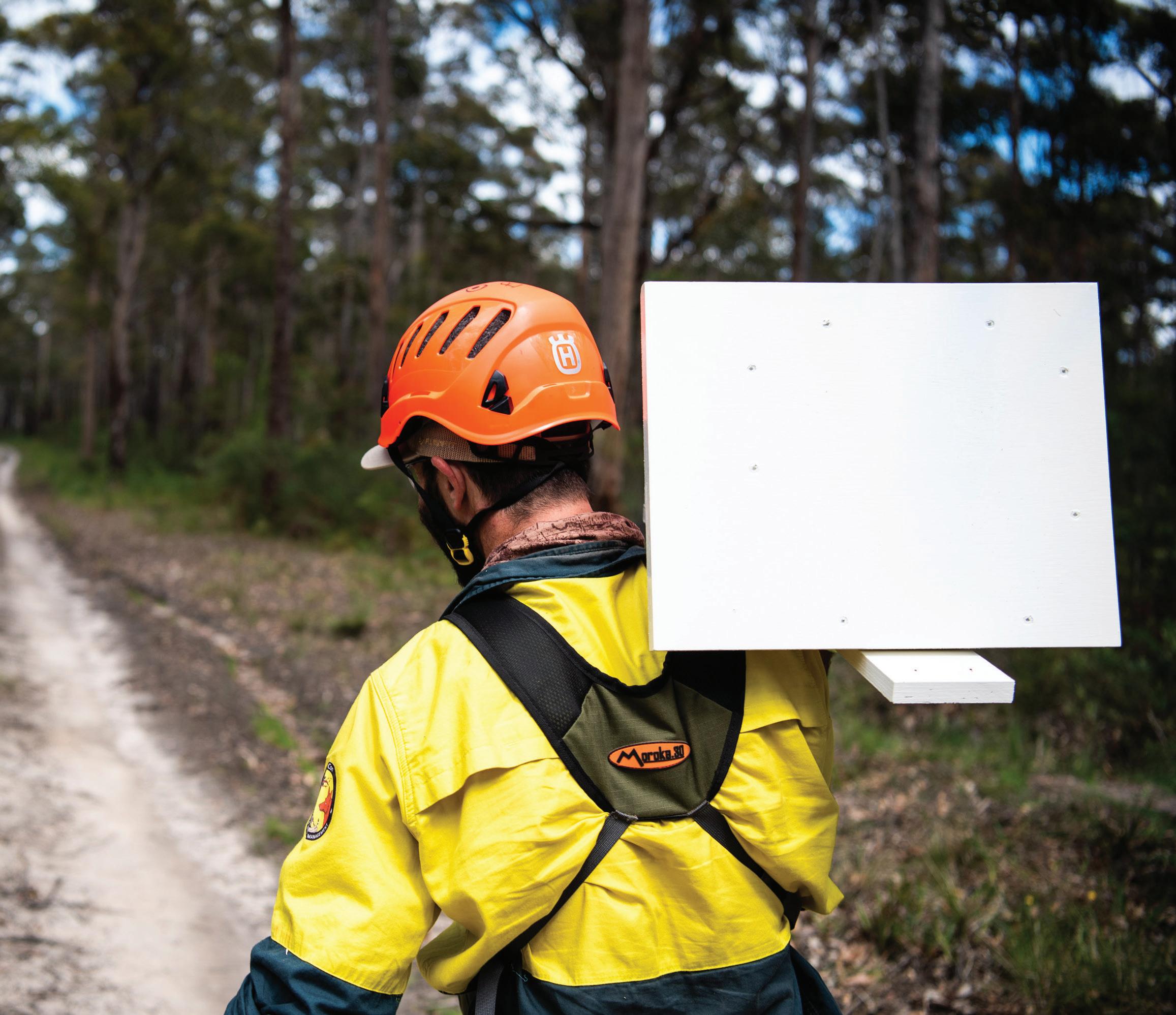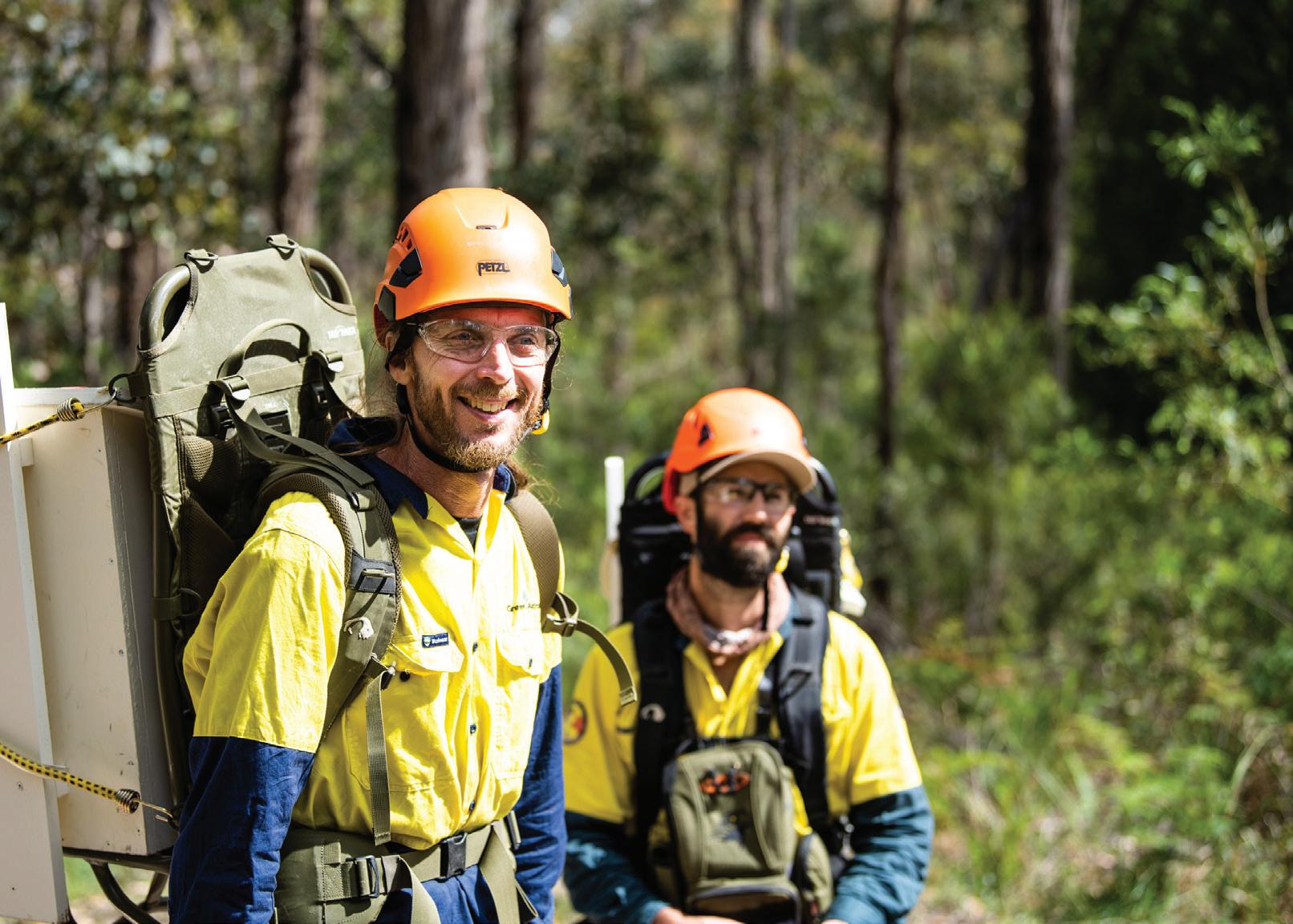
8 minute read
Protecting our precious gliders
GLIDING HIGH
Australia’s iconic greater gliders were hit by devastating habitat loss after the 2019-2020 Black Summer bushfires. Here Drew Liepa – senior program officer at Greening Australia – tells AusBiz. about the Gliding to Recovery program to install 300 nest boxes across East Gippsland’s Hartland State Forest, in conjunction with Landcare Victoria, in an effort to research the little-known species and save it from extinction.
Advertisement
INTERVIEW BY: darcy watt
Q. THE POPULATION OF GLIDERS HAS DIMINISHED BY 80 PER CENT OVER THE PAST 20 YEARS. HOW IS IT MEASURED AFTER EVENTS SUCH AS THE 2019-2020 BLACK SUMMER BUSHFIRES?
It’s challenging to assess the impact on populations immediately after a natural disaster, and even now, two years after the 2019/2020 bushfires began, we still don’t know the full extent of impact of these devastating fires on greater glider populations. We do know that the fires had a significant effect on greater glider populations and their habitat in East Gippsland. Research by Deakin University also found that across Australia, almost 30 per cent of greater glider habitat was burnt in the 2019/2020 fires.
Q. WHAT MAKES THE GREATER GLIDER SUCH A UNIQUE ANIMAL, AND WHY IS IT IMPORTANT TO PROTECT THE SPECIES?
Greater gliders are Australia’s largest gliding mammal. They have large fluffy ears and a long, furry prehensile tail. They can glide up to 100m in a single glide and can change direction at a 90-degree angle mid-flight. Greater gliders play significant ecological and functional roles in ecosystems; they are an important part of forest food webs and their disappearance or population decline risks disrupting the delicate balances that exist in the natural world.
Additionally, taking action before greater gliders disappear entirely from the wild is crucial, as strategies such as captive breeding and reintroduction programs are costly conservation interventions and have increased risks of failure.
Australia is home to an incredibly rich diversity of wildlife and many species are found nowhere else in the world – including greater gliders. It’s critical that we take action to protect and conserve this unique species before it is too late.
Q. WILL CAMERAS BE INSTALLED IN THE GLIDER NEST BOXES TO MONITOR WHETHER THEY ARE BEING USED?
The nest boxes we are installing will be monitored for occupancy (by any species, including greater gliders or sugar gliders) using a thermal monocular and thermal drone flyovers approximately two months after the boxes have been installed.
Using a thermal monocular, Greening Australia has previously observed greater gliders using our nest boxes at other sites in Victoria. The measure of success will come several years later when we survey the area (using thermal drones and on-ground surveys) to ascertain if the population is stable or has increased against baseline data.
Q. DOES THEIR TENDENCY TO INHABIT SMALL, ISOLATED HOME RANGES ALSO HAVE AN IMPACT ON THE GENETIC DIVERSITY OF GREATER GLIDERS?
Although there is currently little understanding about the genetic relationships between greater glider populations, there is a concern that habitat loss and fragmentation is placing the species at further risk of the effects of low genetic diversity.
Greater gliders are unable to move effectively or safely through cleared land to access new habitat or other glider populations, which means that gene flow between populations – genetic exchange via breeding – can be virtually non-existent. This can create low genetic diversity in small and isolated populations.
Populations with low genetic diversity can have a negative impact on population health, including by limiting the ability to adapt to environmental change and increasing the risk of extinction.
DID YOU KNOW?
GREATER GLIDERS ARE ONLY FOUND IN AUSTRALIA, AND REPRODUCE ONCE EVERY TWO YEARS.
Q. DO YOU HAVE ANY FUTURE PLANS TO DEVELOP SIMILAR RESPONSES IN OTHER BUSHFIRE AFFECTED AREAS?
For now the scope of this project is limited to our actions in Hartland State Forest. However an exciting component of this project is the development of a new suite of greater glider genetic markers from scat testing, which will provide environmental practitioners with a powerful tool to better understand, map, plan, monitor and protect populations in the future. The nest box design and the implementation process we are using for this project can also be applied in other locations where greater glider populations live to support the recovery of this vulnerable species.
Additionally, an important component of the Gliding to Recovery project has been involving local Landcare networks and community members. In partnership with Far East Victoria Landcare Network, Greening Australia is delivering community engagement and training events that focus on educating and building the awareness and capacity of locals to assist in conservation efforts.
Q. WHEN WAS IT DECIDED THAT THE PROJECT WAS NECESSARY?
Five years ago survey data highlighted a rapid decline in greater glider population in their stronghold areas including the Southern Highlands of Victoria. Taking action on the ground to address some of the threats facing this species became even more urgent than it already was. Additionally, the bushfires of 2019-2020 destroyed close to 30 per cent of greater glider habitat. The impact of these fires was catastrophic for this already vulnerable species, diminishing suitable hollows and causing drastic habitat fragmentation, so our Gliding to Recovery project provides much needed shelter in unburnt pockets of land.
Q. BESIDES NATURAL DISASTERS, WHAT ARE SOME OF THE OTHER MAIN THREATS TO THIS SPECIES?
Greater gliders’ reliance on forest habitat and large hollow-bearing trees means that habitat loss and fragmentation from land clearing and bushfires pose a major threat to this vulnerable species.
Habitat fragmentation and population isolation also impact the ability of greater gliders to move through landscapes and recolonise suitable habitat, and reduces genetic exchange between subpopulations. As populations decline and become more isolated, they are also more prone to the effects of small population size which could mean genetic decline.
It is well documented that greater gliders also have poor dispersal abilities, occupy very small home ranges (approximately 1-4 hectares) and generally do not breed every year, so population growth is slow. These factors contribute to making the greater glider extremely vulnerable to wildfire and other threats such as hyper-predation by owls.
Climate change also poses a severe threat for this species. Hotter, drier climates predicted may cause heat stress and increased rates of mortality for greater gliders, while more frequent and intense bushfires will continue to contribute to habitat loss and population decline.


Q. SO FAR, WHAT HAVE BEEN THE HIGHLIGHTS OF THE PROJECT?
The enthusiasm and dedication of the project team has been truly inspirational. Spending time immersed in the habitat of greater gliders has given us a greater understanding and appreciation of their preferred glide pathways and feed trees.
Conventional spotlighting to survey greater glider presence has always been a challenging, so our ability to use thermal drones in areas has been a massive highlight. This technique has allowed us to better map the distribution of greater gliders.
Q. WHY IS THERE A LACK OF NATURALLY FORMED TREE HOLLOWS IN THE LANDSCAPE?
Greater gliders prefer to inhabit old-growth forests and the hollows they use for shelter and nesting can take hundreds of years to form. The progressive loss of large hollowbearing trees due to land clearing is happening at a much faster rate than these hollows are formed naturally, leading to a significant lack of hollows for greater gliders.
Q. HOW IS GREENING AUSTRALIA AND LANDCARE VICTORIA INSTALLING THE NESTING BOXES WITHIN THE TREE CANOPY?
We work with a team of expert arborists to install the nest boxes at heights where we know the greater gliders are moving about in the forest. This can be 20-30 metres up in the canopy. Each arborist climbs up the trunk of the tree to install the nest box and is supported by someone on the ground, who will help to hoist the boxes and other necessary tools up into the canopy using ropes.
Q. WHERE DO YOU EXPECT THE POPULATION TO BE A FEW YEARS AFTER THE INSTALLATION OF THE NESTING BOXES?
By implementing 300 nest boxes in Eastern Victoria, we are aiming to enhance critical habitat refugia for greater gliders and prevent further population decline in our target area – Hartland State Forest. Because greater gliders are slow to reproduce (producing only one young roughly every two years) population growth will inevitably be gradual. However, we hope that through targeted, proactive and science-based interventions such as the Gliding to Recovery project, over time we can reverse the decline of greater gliders and help this uniquely Australian animal to thrive.






